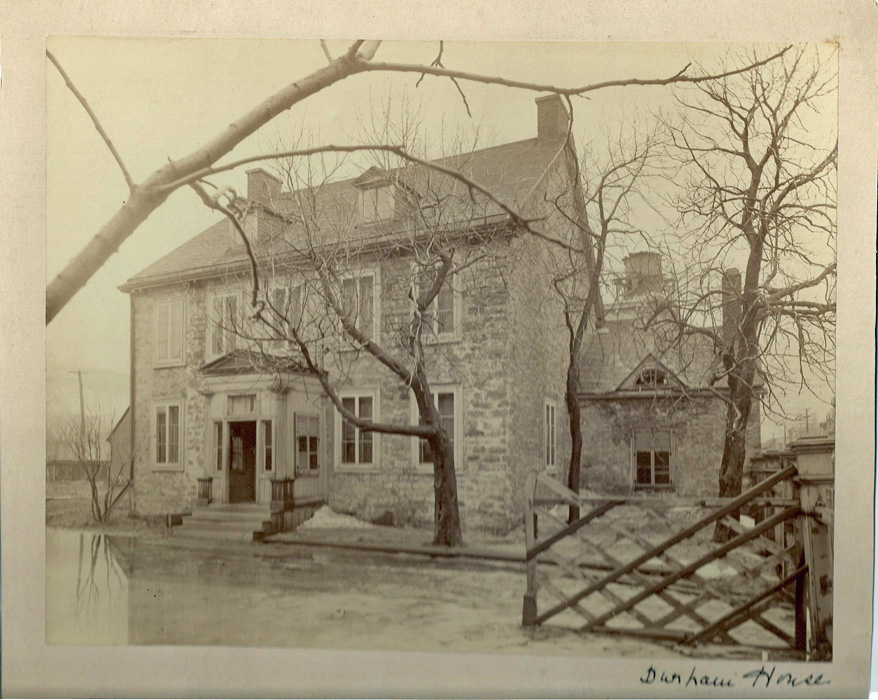On Oct. 17, 1810 in the afternoon, my great-great-great grandfather Stanley Bagg and his father, Phineas, visited the office of a Montreal notary to co-sign a lease for the Mile End Tavern with landlord John Clark. That lease was the first documented evidence of Stanley’s relationship with his future father-in-law.
Although it was not a mile from anywhere significant, the Mile End Tavern was in an excellent location for a drinking establishment, at the corner of St. Lawrence Street, the main road leading north from the city to Rivière des Prairies, and Ste. Catherine Road, which crossed the northern flank of Mount Royal.
Phineas Bagg, who had moved from Massachusetts with his young family about 15 years earlier and operated a hotel in La Prairie for some years, had the experience to run the tavern. But the Mile End property was also a farm, and the lease stipulated that the tenants had to manure the pastures, protect the maple grove, and allow their cows and those belonging to the neighbouring sisters of the Hôtel Dieu to graze together.
Running a tavern and a farm must have kept father and son busy, but Stanley had greater ambitions. During the war of 1812, he and a business partner landed a dangerous contract from the British army to transport iron guns from Montreal to Kingston. Stanley used the profits from this and similar contracts to buy shares in a steamboat, and, being a horse enthusiast, to build a race track near the tavern.
Later, he obtained other army contracts, including the leveling of the Montreal citadel in 1819. In 1821, he and three partners were awarded a contract to excavate the Lachine Canal, a project that took more than four years and involved hiring hundreds of Irish immigrant labourers.
Meanwhile, in 1815, Stanley and Phineas had renewed the tavern lease but, in 1818, with Phineas in his late 60s, they closed the business and placed an ad in the newspaper asking anyone with an outstanding account with the tavern to settle it. A year later, Stanley Bagg and John Clark signed another notarized agreement: it was a marriage contract between Stanley and John’s only daughter, Mary Ann Clark.

Stanley and Mary Ann made an attractive couple. At 31, Stanley had broad shoulders, a straight nose and full lips, while Mary Ann, 24, was slim and dark-haired. As a wedding present, her father gave the couple a handsome two-storey stone house called Durham House, where their only child, Stanley Clark Bagg, was born a year later. The house was named after Durham County, England, where John Clark, a butcher by trade and an investor by aptitude, and his wife were born.
When Stanley and Mary Ann began their lives together in Montreal, the city was already 180 years old, but it was going through a period of rapid change. Stanley Bagg and John Clark took advantage of opportunities that came their way because of those changes, thus laying the foundations of the family’s future.
Post updated with additional photo on May 7, 2015
Research remarks: Those of us who had ancestors in Quebec have a gold-mine of genealogical information at our finger-tips: notarial documents, housed at the Bibliothèque et Archives nationale du Québec (BANQ), the national library and archives of Quebec. Every time someone signed a lease, wrote a will, purchased a property or made a protest (usually because money was owed), a notary prepared the document.
Although these documents can be difficult to find (you have to know the name of the notary before you can even start searching the indexes), the results are often worth the trouble. For example, the Mile End Tavern lease, act # 2874 in the records of notary J.A. Gray, suggests that John Clark was a knowledgeable farmer who cared for the land and valued his relationship with the nuns next door.
Stanley Bagg’s military contracts, the agreement he signed with his business partners to build the Lachine Canal and his marriage contract were also notarial documents that reveal a great deal about his business activities and private life.
The BANQ website (www.banq.qc.ca) is not easy to use, even if you click on the English version. But if you know the name of a notary your ancestor used in the 19th century, try browsing the indexes at http://bibnum2.banq.qc.ca/bna/notaires/index.html. Not all notaries’ indexes have been digitized.
